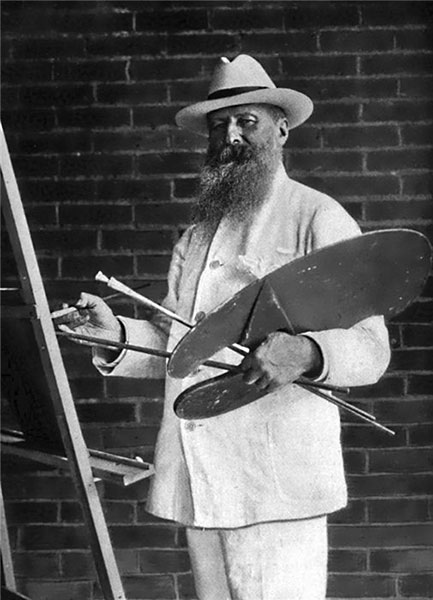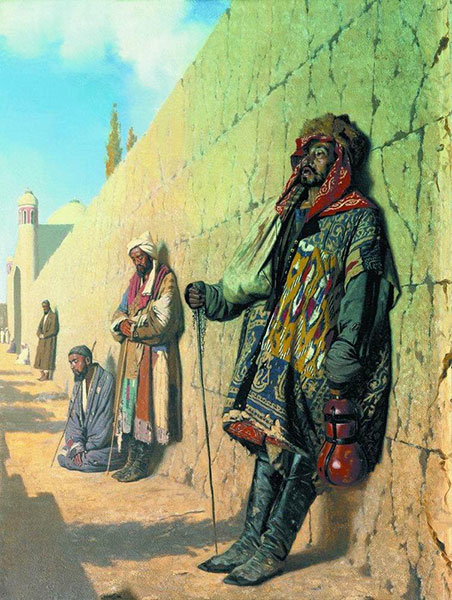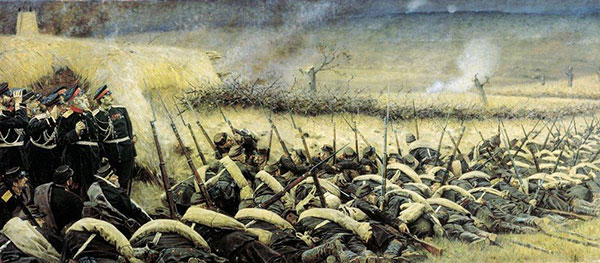
The Artist and Spy
/ Главная / Russkiy Mir Foundation / Publications / The Artist and SpyThe Artist and Spy
The biography of the renowned Russian painter Vasily Vereshchagin, who was born 170 years ago, contains many blank pages. A large portion of his sketches and travel journals disappeared without a trace, and they could tell us much about this man, who was engaged in more than just painting…

In Vasily Vershchagin’s family, which was lead by a leading nobleman and brilliant military officer, the fate of all four sons was sealed from birth: everyone was destined to serve in the Russian army. But one day young Vasily, who was born in Cheropovets in 1842, was given a set of pencils. And this changed everything. Or almost everything…
At eight years old, his parents took Vasily to St. Petersburg to attend the Alexander Cadet Corps. In secret, he brought with him his drawings and pencils, as his father thought this hobby to be nonsense. He later continued his studies at the elite Naval Cadet Corps but in his free time he attended the school of the Imperial Society for the Encouragement of the Arts. He graduated from both institutions but only made his decision in favor of the arts three years later when he resigned from military service.
Vasily’s father refused to speak with his son and, after learning that his errant son had entered the Academy of Arts, he forbade the mentioning of Vasily at home.
Secret Missions
In the winter of 1863, the already retired officer Vasily Vereshchagin was called into the Military Ministry. It was suggested that he see the world and illustrate what he saw. The ministry would cover all his expenses. There was only one small request: to make detailed notes of everything he saw and send his reports to St. Petersburg. It did not take long for him to make p his mind.
In 1863 he left for the Caucasus, which following many years of war with mountain tribes had been annexed into the Russian Empire. He travelled along the Georgian Military Road and lived in Tbilisi. He made sketches of the natural surrounding and struck up conversations with the locals about all sorts of topics, handing out “royalties” and gifts in exchange for particularly interesting information. And he kept a detailed travel journal.
Vereshchagin liked the nomadic life. Traveling, dangers and a multitude of impressions. No need to worry about making a living and he could draw as much as he liked. The ministry was also satisfied with the Caucasus mission of the artist. Konstantin Kaufman, governor-general and commander of Russian forces in Central Asia, soon received a secret communiqu
Thus Vereshchagin wound up in the middle of the war to annex Turkestan. He once again donned his uniform and together with the garrison protected the Samarkand fortress from raids by horsemen of the unsubmissive emirs. He went on reconnaissance missions and participated in hand-to-hand combat. And he continued to draw, all the meanwhile not forgetting to keep his travel journal. His stay in Turkestan resulted in his receiving the Cross of St. George and also two exhibits in St. Petersburg.
People started talking about Vereshchagin. His paintings and drawings were admired by Vladimir Stasov and Ivan Kramskoi, and Pavel Tretyakov purchased several of his canvases. A public that was largely accustomed to salon paintings discovered the very different world of The Poor of Samarkand and Politicians in an Opium Shop. Authorities however were taken aback by the battlefield paintings and in particular criticized The Apotheosis of War. Skulls and crows… but where were the defeated enemies and generals in full dress? The artist took great offense. A nervous breakdown resulted in him burning three of his wonderful paintings: The Forgotten Soldier, Surrounded and Pursued and Entering at the City Gates. And then he defiantly rejected the title of professor, which had been awarded him in 1874 by the Academy of Arts.
Vereshchagin set off on his next journey, cursing the “fattened, stupid and corrupt Petersburg.” His mission to India almost became his last. Vereshchagin travelled to the most remote regions, journeying through the foothills of the Himalayas and Tibet. He studied the coast of the India Ocean, as always making lots of drawings and notes. The British colonialists eventually got fed up with this all too curious Russian artists. He was tailed and then pursued. In the foothills of the Himalayas Vereshchagin barely escaped an avalanche. When attempting to cross the Ganges he nearly drowned – the bottom of the boat turned out to have leaks. He was abandoned by his guides and caught a fever. After a long ordeal and many hardships Vereshchagin returned to Russia, only to continue to tempt fate.
The Siege of Plevna
In 1876 war broke out with Turkey. Vereshchagin once again joined the effort. He served as aide-de-camp to the commander of the Russian Army Grand Duke Nicholas with the right to freely move among the military units.
In the summer of 1877 together with a group of the Danube fleet, Vereshchagin participated in the storming of a Turkish vessel. He was seriously wounded and miraculously avoided falling prisoner. Having barely recovered he joined the Russian camp laying siege to the fortress of Plevna, which the Turks were bravely defending. After the successful capture of the fortress, he set out with a group of Bulgarian volunteers, exploring the liberated country…

The Balkan war left him with numerous agonizing memories. Piles of corpses, the cries of the wounded, disfigured veterans in the markets… During the third attempt to storm Plevna, Vasily’s younger brother Sergei, who also had graduated from the Naval Cadet Corps and was a promising artist, was killed. Another brother, Alexander, an officer of the general staff, was seriously wounded. To make matters worse, 40 of his artworks from the Balkan campaign were mysteriously lost or stolen.
Upon returning to St. Petersburg, the artist finally received well-deserved recognition. In 1880 and 1883 two grandiose exhibits on the Russo-Turkish War were held. Vereshchagin received a hero’s welcome. Everyone knew that he was seriously wounded, that he participated in the storming of Plevna and that he was awarded for valor. His paintings were an enormous success, although they are only purchased by collectors, among whom were Pavel Tretyakov.
Vereshchagin wrote to his friend Vladimir Stasov: “I will paint no more battle scenes – basta! I take what I paint too close to heart. And there’s the result. I endured all of these horrors. They can never understand this. I will find other subjects…”
The artist travelled to Palestine. He paints Solomon’s Wall and The Kings’ Tomb. Later, in his enormous studio in Moscow, he worked on paintings dedicated to the Patriotic War of 1812. Personal exhibitions are held of the artist’s work in St. Petersburg and Moscow as well as in London, Paris, Vienna, Berlin and even New York. These were also missions, but of a different sort – calmer. The artist personally gave tours of his art work to a number of famous people, simultaneously inquiring about their opinions and business.
The Final Mission
In the early 20th century the world once again began to smell of gunpowder. The interests of Russia and Japan collided in Manchuria. The artist was thus dispatched to the Land of the Rising Sun. For a period of time, thanks to his wonderful command of English and French, Vereshchagin succeeded in traveling practically unhindered, painting and conversing with the locals. However, once upon returning to his hotel he discovered that someone had very professionally gone through his personal items. He had to flee. The Russian general command called the information he provided “invaluable.”
In 1904 the Russo-Japanese War broke out. On March 31, Vasily Vereshchagin died aboard the battleship Petropavlovsk outside of Port Arthur after the vessel hit Japanese mines. In St. Petersburg a major exhibition was opened in honor of the artist. Ilya Repin called him “the greatest artist of our time, a colossal and mysterious person.”
Ilya Repin was correct. Then few knew of the difficult fate of Vasily Vereshchagin, who dedicated both of his lives to serving Russia.
Sergei Muraviev
Newspaper Trud
New publications

 Mikhail Kalatozov, a director who transformed the world of cinematography in many ways, was born 120 years ago. He was a Soviet film official and a propagandist. Above all, he was capable of producing movies that struck viewers with their power and poetic language.
Mikhail Kalatozov, a director who transformed the world of cinematography in many ways, was born 120 years ago. He was a Soviet film official and a propagandist. Above all, he was capable of producing movies that struck viewers with their power and poetic language.  Ukrainian authorities have launched a persecution campaign against the canonical Ukrainian Orthodox Church (UOC), the biggest one in the country's modern history. Over the past year, state sanctions were imposed on clergy representatives, searches were conducted in churches, clergymen were arrested, criminal cases were initiated, the activity of the UOC was banned in various regions of the country, and monasteries and churches were seized.
Ukrainian authorities have launched a persecution campaign against the canonical Ukrainian Orthodox Church (UOC), the biggest one in the country's modern history. Over the past year, state sanctions were imposed on clergy representatives, searches were conducted in churches, clergymen were arrested, criminal cases were initiated, the activity of the UOC was banned in various regions of the country, and monasteries and churches were seized.  When Nektary Kotlyaroff, a fourth-generation Russian Australian and founder of the Russian Orthodox Choir in Sydney, first visited Russia, the first person he spoke to was a cab driver at the airport. Having heard that Nektariy's ancestors left Russia more than 100 years ago, the driver was astonished, "How come you haven't forgotten the Russian language?" Nektary Kotlyaroff repeated his answer in an interview with the Russkiy Mir. His affinity to the Orthodox Church (many of his ancestors and relatives were priests) and the traditions of a large Russian family brought from Russia helped him to preserve the Russian language.
When Nektary Kotlyaroff, a fourth-generation Russian Australian and founder of the Russian Orthodox Choir in Sydney, first visited Russia, the first person he spoke to was a cab driver at the airport. Having heard that Nektariy's ancestors left Russia more than 100 years ago, the driver was astonished, "How come you haven't forgotten the Russian language?" Nektary Kotlyaroff repeated his answer in an interview with the Russkiy Mir. His affinity to the Orthodox Church (many of his ancestors and relatives were priests) and the traditions of a large Russian family brought from Russia helped him to preserve the Russian language.

 The leaders of the Friends of the Great Russia cultural association (Amici Della Grande Russia) in Italy believe that the Western policy of abolishing Russian culture in Europe has finally failed. Furthermore, it was doomed to failure from the beginning.
The leaders of the Friends of the Great Russia cultural association (Amici Della Grande Russia) in Italy believe that the Western policy of abolishing Russian culture in Europe has finally failed. Furthermore, it was doomed to failure from the beginning.  Name of Vladimir Nemirovich-Danchenko is inscribed in the history of Russian theater along with Konstantin Stanislavski, the other founding father of the Moscow Art Theater. Nevertheless, Mr. Nemirovich-Danchenko was a renowned writer, playwright, and theater teacher even before their famous meeting in the Slavic Bazaar restaurant. Furthermore, it was Mr. Nemirovich-Danchenko who came up with the idea of establishing a new "people's" theater believing that the theater could become a "department of public education."
Name of Vladimir Nemirovich-Danchenko is inscribed in the history of Russian theater along with Konstantin Stanislavski, the other founding father of the Moscow Art Theater. Nevertheless, Mr. Nemirovich-Danchenko was a renowned writer, playwright, and theater teacher even before their famous meeting in the Slavic Bazaar restaurant. Furthermore, it was Mr. Nemirovich-Danchenko who came up with the idea of establishing a new "people's" theater believing that the theater could become a "department of public education."  "Russia is a thing of which the intellect cannot conceive..." by Fyodor Tyutchev are famous among Russians at least. December marks the 220th anniversary of the poet's birth. Yet, he never considered poetry to be his life's mission and was preoccupied with matters of a global scale. Mr.Tyutchev fought his war focusing on relations between Russia and the West, the origins of mutual misunderstanding, and the origins of Russophobia. When you read his works today, it feels as though he saw things coming in a crystal ball...
"Russia is a thing of which the intellect cannot conceive..." by Fyodor Tyutchev are famous among Russians at least. December marks the 220th anniversary of the poet's birth. Yet, he never considered poetry to be his life's mission and was preoccupied with matters of a global scale. Mr.Tyutchev fought his war focusing on relations between Russia and the West, the origins of mutual misunderstanding, and the origins of Russophobia. When you read his works today, it feels as though he saw things coming in a crystal ball...